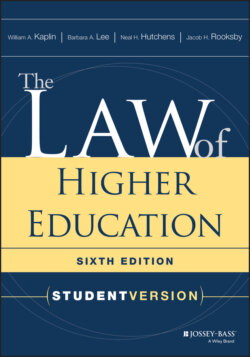Читать книгу The Law of Higher Education - William A. Kaplin - Страница 22
A. The Universe of Education Law
ОглавлениеHigher education is part of a broader universe of education law. This universe encompasses not only the law regarding higher and other postsecondary education but also the law regarding “lower” education, that is, elementary and secondary education (K–12) as well as preschool education.1 These “higher” and “lower” sectors can be further divided into public education and private education sectors, as indicated in Figure I.1, thus producing a universe of four quadrants: public higher education, public lower education, private higher education, and private lower education. Finally, the private education quadrants can be subdivided into private education provided by secular institutions and private education provided by religious institutions, as Figure I.1 also indicates. Each sector displayed in Figure I.1 is legally distinct from the other sectors. The boundary lines within the education law universe thus represent important legal distinctions—distinctions undergirding legal analysis of education law problems. (For an example, see State ex rel. Gallwey v. Grimm, 48 P.3d 274, 279–84 (Wash. S. Ct., 2002) [state constitution's restriction on state funding of “schools” does not apply to higher education].) Because the applicable sources of law (Section 1.4 of this book), the legal reasoning, and the results or conclusions reached may differ from one sector to another, it is important to begin analysis of each judicial opinion by determining the sector of the education law universe with which it deals. Similarly, when first approaching a new issue or problem, it is important to ascertain its location within this universe.
Figure I.1 The Education Law Universe
In a higher education law course, therefore, one would ask: Does this case or problem deal with public higher education or with private higher education? (See Section 1.5 of this book for discussion of this distinction.) If it is private higher education, then one would ask: Does this case or problem deal with secular higher education or with religious higher education? (See Section 1.6 for discussion of this distinction.) To further expand understanding, one could also ask whether the problem or case would be reasoned or resolved differently—and why—if it had involved private rather than public (or public rather than private) higher education, or had involved religious rather than secular (or secular rather than religious) higher education. Finally, for the broadest perspective, one might ask whether the case or problem would be reasoned or resolved differently if it had involved lower education rather than higher education.
These distinctions and their significance in various contexts are emphasized throughout the Student Version.
